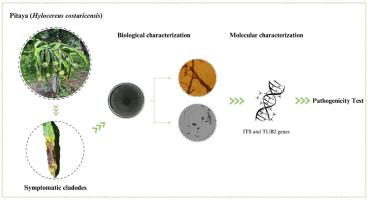当前位置:
X-MOL 学术
›
Crop Prot.
›
论文详情
Our official English website, www.x-mol.net, welcomes your feedback! (Note: you will need to create a separate account there.)
First report of Neoscytalidium dimidiatum causing stem canker on pitaya (Hylocereus costaricensis) in Pará, Brazil
Crop Protection ( IF 2.5 ) Pub Date : 2024-06-04 , DOI: 10.1016/j.cropro.2024.106788 Igor Henrique de Lima Costa , Mario Fernando Pinel Alvarez , Emanueli Bizarro Furtado , Cândida Renata Jacobsen de Farias , Danielle Ribeiro de Barros , Frederico Schmitt Kremer , Dejalmo Nolasco Prestes , Alvaro Renato Guerra Dias
Crop Protection ( IF 2.5 ) Pub Date : 2024-06-04 , DOI: 10.1016/j.cropro.2024.106788 Igor Henrique de Lima Costa , Mario Fernando Pinel Alvarez , Emanueli Bizarro Furtado , Cândida Renata Jacobsen de Farias , Danielle Ribeiro de Barros , Frederico Schmitt Kremer , Dejalmo Nolasco Prestes , Alvaro Renato Guerra Dias

|
Pitaya ( spp.) is a cactus cultivated in regions with a tropical and subtropical climate. In Brazil, the installation of pitaya orchards has spread nationwide, and some diseases associated with phytopathogens have been reported. In Pará, a state located in the North of Brazil, the constant association of a fungus in pitayas, characteristic of the genus , was observed, manifesting symptoms of stem canker. Therefore, this study aimed to identify and confirm the causal agent associated with stem canker in pitayas () in Pará, Brazil. Symptomatic pitaya cladodes were used to isolate the pathogens. Subsequently, the macroscopic and microscopic characteristics of the colonies, molecular analysis, and pathogenicity test were carried out. The pathogen showed rapid growth on PDA, with a diameter of approximately 8–9 cm, after 4–5 days of incubation at 25 °C with light gray colonies in 5 days and dark gray in 14 days. Microscopic evaluation showed septate and branched hyphae. The conidia are ellipsoid to ovoid, with smooth walls and disarticulated, and may have one or zero septa, with an average size of 7.2–12x3-7.8 μm. Molecular analysis, using the ITS and TUB2 sequences, showed 100% identity with the phytopathogenic fungus , according to BLAST analysis. In the phylogenetic tree, the isolate was close to isolates from China and Vietnam. Furthermore, the pathogenicity test confirmed the fungus as a causal phytopathogen associated with stem canker in pitaya () in Pará, Brazil. These findings may assist in future studies to manage the disease.
更新日期:2024-06-04
















































 京公网安备 11010802027423号
京公网安备 11010802027423号